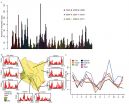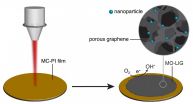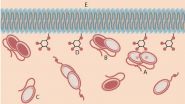INFORMATION:
Participating institutions include: Columbia University; Purdue University; Rensselaer Polytechnic Institute; Rice University; University of California, Los Angeles; University of California, San Diego; University of Chicago; Istituto Nazionale di Fisica Nucleare, Bologna, Italy; Istituto Nazionale di Fisica Nucleare, Laboratori Nazionale del Gran Sasso, l'Aquila, Italy; Istituto Nazionale di Fisica Nucleare, Torino, Italy; University of Bologna, Italy; Johannes Gutenberg University, Mainz, Germany; Max-Planck-Institut für Kernphysik, Heidelberg, Germany; University of Münster, Germany; University of Bern, Switzerland; University of Zürich, Switzerland; Nikhef & GRAPPA/University of Amsterdam, the Netherlands; Subatech, Nantes, France; Stockholm University, Sweden; Weizmann Institute of Science, Rehovot, Israel; NYU Abu Dhabi, United Arab Emirates; and the University of Coimbra, Portugal.
The experiment is supported by the National Science Foundation, Department of Energy, Swiss National Science Foundation, Volkswagen Foundation, Bundesministerium für Bildung und Forschung, Max Planck Gesellschaft, Research Center Elementary Forces and Mathematical Foundations, Foundation for Fundamental Research on Matter, Weizmann Institute of Science, Initial Training Network Invisibles, Fundacao para a Ciencia e a Tecnologia, Region des Pays de la Loire, Science and Technology Commission of Shanghai Municipality, National Natural Science Foundation of China, and Istituto Nazionale di Fisica Nucleare.
Writer: Elizabeth K. Gardner, 765-494-2081, ekgardner@purdue.edu
Sources: Rafael Lang, 765-494-3048, Rafael@purdue.edu
Joachim Kopp, jkopp@uni-mainz.de
Luke Goetzke, lwg2107@columbia.edu
Elena Aprile, age@astro.columbia.edu
Related websites:
XENON Project website: http://xenon.astro.columbia.edu/index.html
ABSTRACT
Exclusion of Leptophilic Dark Matter Models using XENON100 Electronic Recoil Data
The XENON Collaboration (Science paper)
Laboratory experiments searching for galactic dark matter particles scattering off nuclei have so far not been able to establish discovery. We use data from the XENON100 experiment to search for dark matter interacting with electrons. With no evidence for a signal above the low background of our experiment, we exclude a variety of representative dark matter models that would induce electronic recoils. For axial-vector couplings to electrons, we exclude cross-sections above 6x10-35 cm2 for particle masses of mx= 2 GeV/c2. Independent of the dark matter halo, we exclude leptophilic models as explanation for the long-standing DAMA/LIBRA signal, such as couplings to electrons through axial-vector interactions at a 4.4σ confidence level, mirror dark matter at 3.6σ, and luminous dark matter at 4.6σ.
ABSTRACT
Search for Event Rate Modulation in XENON100 Electronic Recoil Data
The XENON Collaboration (PRL paper)
We have searched for periodic variations of the electronic recoil event rate in the (2-6)keV energy range recorded between February 2011 and March 2012 with the XENON100 detector, adding up to 224.6 live days in total. Following a detailed study to establish the stability of the detector and its background contributions during this run, we performed an un-binned profile likelihood analysis to identify any periodicity up to 500 days. We find a global significance of less than 1σ for all periods suggesting no statistically significant modulation in the data. While the local significance for an annual modulation is 2.8σ, the analysis of a multiple-scatter control sample and the phase of the modulation disfavor a dark matter interpretation. The DAMA/LIBRA annual modulation interpreted as dark matter signature with axial-vector coupling of WIMPs to electrons is excluded at 4.8σ.
A detector shines in search for dark matter
2015-08-20
(Press-News.org) WEST LAFAYETTE, Ind. -- Results of the XENON100 experiment are a bright spot in the search for dark matter.
The team of international scientists involved in the project demonstrated the sensitivity of their detector and recorded results that challenge several dark matter models and a longstanding claim of dark matter detection. Papers detailing the results will be published in upcoming issues of the journals Science and Physical Review Letters.
Dark matter is an abundant but unseen matter in the universe considered responsible for the gravitational force that keeps the Milky Way galaxy together, said Rafael Lang, an assistant professor of physics at Purdue University who was involved in the research.
"Our galaxy spins like an incredibly fast merry-go-round, and the stars, planets and other objects would go flying off in different directions if it wasn't for gravitational pull," he said. "When we calculate the gravity of every known mass, it is nowhere near enough force to keep the galaxy together. Dark matter is the stuff that makes up the difference."
Although the team did not detect dark matter, the capabilities demonstrated by the XENON100 detector are encouraging. The high sensitivity shown in the experimental results could free the international research team from the need to constrain analysis to only a portion of the data captured, Lang said.
"Imagine the search for a very weak and elusive dark matter signal within many events from various sources of background," Lang said. "It's like looking for a needle in a haystack. While most experiments have a huge pile of hay, our detector is so sharp and the background is so low, that our haystack is small and we can easily look at every piece of hay. We don't have to pick and choose what portion of the data we evaluate; we can look at every event. This opens the door for us to find evidence of dark matter in an unexpected place or in a form we didn't consider, which is good because no one yet knows what exactly dark matter is."
Scientists from a dark matter project named Dark Matter Large Sodium Iodide Bulk for Rare Processes, and referred to as the DAMA/LIBRA project, claimed to have detected dark matter in 1998. The team observed a signal that varied with the seasons, as is expected for dark matter as the Earth's orbit around the sun changes the speed at which it passes through a halo of dark matter that envelops the Milky Way, Lang said.
However, other teams searching for dark matter did not observe the same signal. The DAMA/LIBRA team suggested that other groups could be blind to the signal because the dark matter was interacting with the atoms of the detector in an unexpected way. It was suggested that the dark matter could be leptophilic, meaning it prefers to interact with electrons, he said.
"Traditionally the 'smoking gun' signature of dark matter was considered to be scattering of dark matter particles on the nuclei of the atoms of the detector material," said Joachim Kopp, a professor of theoretical elementary particle physics at Johannes Gutenberg University Mainz who is not part of the XENON collaboration. "Indeed, this is what many well-motivated dark matter models, such as supersymmetry, predict. However, in recent years, we have begun to appreciate more and more the fact that dark matter could behave very differently in many ways."
Experimental anomalies like the controversial annual modulation signal observed in the DAMA/LIBRA project cannot be explained by traditional dark matter scattering on atomic nuclei, but could be accommodated more easily if dark matter scatters predominantly with electrons or if most of the energy released in dark matter scattering is in the form of photons, he said.
"For a long time, it was considered unfeasible to test such a model since the scattering of dark matter particles on electrons or the emission of photons is much more difficult to distinguish from radioactive backgrounds," Kopp said. "Liquid noble gas detectors like XENON100 are now setting the new gold standard in this endeavor."
The XENON100 experiment was able to examine theories others could not because of the low level of background events it achieved, said Luke Goetzke, a postdoctoral researcher at Columbia University who was a lead researcher on the XENON100 experiment detailed in Physical Review Letters.
"The material used in the XENON100 detector and the material used in the DAMA/LIBRA project are very similar in terms of their electron configurations, so if dark matter interacts with one, it would interact in nearly the same way with the other," he said. "However, the XENON100 detector is so amazingly sensitive that the signal would be much more clear. We did not see it, and given our current knowledge and understanding of physics, because we did not see it, there is no way to explain the mysterious signal as leptophilic dark matter."
While the XENON100 data did not show the same signal as that observed by the DAMA/LIBRA project, the data did show a different and faint annual modulation, he said.
"The modulation we observed raises some questions, and to me that is thrilling," Goetzke said. "This means we are pushing the limits of our understanding and that is what makes physics research fun. I am very excited to see the first data from the XENON1T experiment, which will push far beyond the already amazing results from XENON100."
The experiment is conducted by an international collaboration of 120 scientists from 22 institutions around the world and is led by Elena Aprile, a professor of astrophysics at Columbia University.
This fall the team will will deploy a next-generation detector called XENON1T, which is expected to be 100 times more sensitive than XENON100. The detector itself will be 20 times bigger and include a series of technological improvements, she said.
"From the XENON100 results we know a lot more about what dark matter is not, which is very valuable information in the field of particle physics," Aprile said. "We've ruled out models with the strongest expected dark matter interactions, and with the XENON1T detector we will be able to test those with weaker expected interactions and capture even the most feeble hint of a dark matter. The results of these experiments mean that if this is the right place to look for the signature of dark matter, we should be able to see it."
The goal of XENON100 and XENON1T experiments is to capture signatures of dark matter that flow through the Earth as it moves through space. To shield the detectors from cosmic radiation that could create background events, they are located under a mountain in the Gran Sasso National Laboratory in Italy, the world's largest underground laboratory. The detectors use the noble gas xenon, kept liquid in a stainless steel container shielded and buried beneath one mile of rock. The detector is equipped with electronics that can detect even individual electrons and photons generated anywhere within the xenon, Lang said.
The XENON experiment is a collaboration of 120 scientists, representing 24 different nationalities and 22 institutions across the world. In addition, around 60 graduate students are working in the collaboration, he said.
ELSE PRESS RELEASES FROM THIS DATE:
School vacations and humidity linked to multiple waves of influenza in Mexico during the 2009 H1N1 pandemic
2015-08-20
Scientists studying the 2009 A/H1N1 influenza pandemic have found that the inconsistent regional timing of pandemic waves in Mexico was the result of interactions between school breaks and regional variations in humidity.
The research published in PLOS Computational Biology, led by Dr. James Tamerius at the University of Iowa and Dr. Gerardo Chowell at Georgia State University, applied mathematical models to understand the social and environmental processes that generated two distinct pandemic outbreaks ("waves") in Mexico during the summer and fall of 2009.
The summer ...
Maltreated children's brains show 'encouraging' ability to regulate emotions
2015-08-20
Children who have been abused or exposed to other types of trauma typically experience more intense emotions than their peers, a byproduct of living in volatile, dangerous environments.
But what if those kids could regulate their emotions? Could that better help them cope with difficult situations? Would it impact how effective therapy might be for them?
A University of Washington-led team of researchers sought to address those questions by studying what happens in the brains of maltreated adolescents when they viewed emotional images, and then tried to control their ...
Cellphone data can track infectious diseases
2015-08-20
PRINCETON, N.J.--Tracking mobile phone data is often associated with privacy issues, but these vast datasets could be the key to understanding how infectious diseases are spread seasonally, according to a study published in the Proceedings of the National Academy of Sciences.
Princeton University and Harvard University researchers used anonymous mobile phone records for more than 15 million people to track the spread of rubella in Kenya and were able to quantitatively show for the first time that mobile phone data can predict seasonal disease patterns.
Harnessing ...
Study finds e-cigarette use linked to cough reflex sensitivity
2015-08-20
Glenview, Ill. (August 20, 2015)--The popularity of electronic cigarettes has steadily increased worldwide, but little is known about their effects on health. New research suggests that the single use of an electronic cigarette approximating the nicotine exposure of one tobacco cigarette reduces the sensitivity of the cough reflex.
The study tested 30 adult lifetime nonsmokers with no history of asthma or respiratory diseases and used cough tests to determine how e-cigarettes affect the cough reflex. Capsaicin, the pungent extract of red peppers, was used to induce a ...
Patent expirations for blockbuster antipsychotic meds could save billions
2015-08-20
Medicaid is expected to save billions of dollars a year as patents for several blockbuster antipsychotic medications expire and use of generic versions of these drugs increases, according to a new study by researchers at the University of Maryland School of Medicine. These savings may provide relief from the high costs of these medications and allow policymakers to lift restrictions on patients' access, the researchers argue.
The study forecast that annual Medicaid payments for antipsychotic medicines will decrease by nearly $1.8 billion (or nearly 50 percent) by 2016 ...
Laser-burned graphene gains metallic powers
2015-08-20
HOUSTON - (Aug. 20, 2015) - Rice University chemists who developed a unique form of graphene have found a way to embed metallic nanoparticles that turn the material into a useful catalyst for fuel cells and other applications.
Laser-induced graphene, created by the Rice lab of chemist James Tour last year, is a flexible film with a surface of porous graphene made by exposing a common plastic known as polyimide to a commercial laser-scribing beam. The researchers have now found a way to enhance the product with reactive metals.
The research appears this month in the ...
The Sumatran rhino is extinct in the wild in Malaysia
2015-08-20
Leading scientists and experts in the field of rhino conservation state in a new paper that it is safe to consider the Sumatran rhinoceros extinct in the wild in Malaysia. The survival of the Sumatran rhino now depends on the 100 or fewer remaining individuals in the wild in Indonesia and the nine rhinos in captivity.
Despite intensive survey efforts, there have been no signs of the wild Sumatran rhinoceros (Dicerorhinus sumatrensis) in Malaysia since 2007, apart from two females that were captured for breeding purposes in 2011 and 2014. Scientists now consider the species ...
Study provides hope for some human stem cell therapies
2015-08-20
An international team of scientists headed by biologists at UC San Diego has discovered that an important class of stem cells known as human "induced pluripotent stem cells," or iPSCs, which are derived from an individual's own cells, can be differentiated into various types of functional cells with different fates of immune rejection.
The scientists also found that these cells may not be rejected by the immune system if iPSCs are turned into retinal pigment epithelium cells destined for the eye.
Their discovery provides hope for the development of human stem cell therapies ...
The human genome: A complex orchestra
2015-08-20
A team of Swiss geneticists from the University of Geneva (UNIGE), the École Polytechnique Fédérale de Lausanne (EPFL), and the University of Lausanne (UNIL) discovered that genetic variation has the potential to affect the state of the genome at many, seemingly separated, positions and thus modulate gene activity, much like a conductor directing the performers of a musical ensemble to play in harmony. These unexpected results, published in Cell, reveal the versatility of genome regulation and offer insights into the way it is orchestrated.
Chromatin, a ...
Carnegie Mellon-led team identifies structure of tumor-suppressing protein
2015-08-20
An international group of researchers led by Carnegie Mellon University physicists Mathias Lösche and Frank Heinrich have established the structure of an important tumor suppressing protein, PTEN. Their findings provide new insights into how the protein regulates cell growth and how mutations in the gene that encodes the protein can lead to cancer. The study is published online in Structure, and will appear in the Oct. 6 issue.
Phosphatase and tensin homolog (PTEN) is a known tumor suppressing protein that is encoded by the PTEN gene. When expressed normally, the ...



